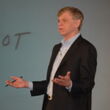Quiet Leadership: Six Steps to Transforming Performance at Work
(Libby/OverDrive eAudiobook)
Available Platforms
Description
Improving the performance of your employees involves one of the hardest challenges in the known universe: changing the way they think. In constant demand as a coach, speaker, and consultant to companies around the world, David Rock has proven that the secret to leading people (and living and working with them) is found in the space between their ears. ""If people are being paid to think,"" he writes, ""isn't it time the business world found out what the thing doing the work, the brain, is all about?"" Supported by the latest groundbreaking research, Quiet Leadership provides a brain-based approach that will help busy leaders, executives, and managers improve their own and their colleagues' performance. Rock offers a practical, six-step guide to making permanent workplace performance change by unleashing higher productivity, new levels of morale, and greater job satisfaction.
More Details
Published Reviews
Publisher's Weekly Review
A leader's job "should be to help people make their own connections," Rock asserts-a commonsense message he overcomplicates in this guide for executives and managers who want to improve employee performance. Rock, CEO of Results Coaching System, strives to legitimize his methodology with neuroscience, acronyms and catchphrases and gratuitous, Powerpointesque illustrations. But his writing style conflicts with his advice-keep it succinct and focused. Promising that his approach "saves time and creates energy," he details his six steps: "Think About Thinking" (let people think things through without telling them what to do, while remaining "solutions-focused"); "Listen for Potential" (be a sounding board for employees); "Speak with Intent" (clarify and streamline conversation); "Dance Toward Insight" (communicate in ways that promote other people's insights); "CREATE New Thinking" (which stands for Current Reality, Explore Alternatives and Tap Their Energy, an acronym about "helping people turn their insights into habits"); and, finally, "Follow Up" to ensure ongoing improved performance. Rock also explains how to apply the steps to problem solving, decision making and giving feedback. Perhaps Rock conveys his strategies more effectively in a seminar setting, but for busy executives, this guide (after Personal Best) is more likely to generate frustration than an " `aha' moment." (Apr.) (c) Copyright PWxyz, LLC. All rights reserved
Library Journal Review
From the title, this work sounds subdued. But Rock (CEO, Results Coaching Systems; Personal Best) actually grounds his ideas in dynamic discoveries about how the human brain works. Typical management approaches to changing behavior fail to account for the surprising differences in how each person processes information and solves problems. Rock suggests that it's far more effective to build new neural pathways to learn new habits than to deconstruct old ones. Transforming performance involves listening and communicating in more positive and effective ways. The ultimate goal of quiet leadership is to empower employees to think and solve problems for themselves. This highly practical guide includes exercises for each major concept introduced, giving readers a chance to practice what they've learned. A brief bibliography highlights research for further reading. Recommended for public library business collections. (c) Copyright 2010. Library Journals LLC, a wholly owned subsidiary of Media Source, Inc. No redistribution permitted.
Library Journal Reviews
From the title, this work sounds subdued. But Rock (CEO, Results Coaching Systems; Personal Best ) actually grounds his ideas in dynamic discoveries about how the human brain works. Typical management approaches to changing behavior fail to account for the surprising differences in how each person processes information and solves problems. Rock suggests that it's far more effective to build new neural pathways to learn new habits than to deconstruct old ones. Transforming performance involves listening and communicating in more positive and effective ways. The ultimate goal of quiet leadership is to empower employees to think and solve problems for themselves. This highly practical guide includes exercises for each major concept introduced, giving readers a chance to practice what they've learned. A brief bibliography highlights research for further reading. Recommended for public library business collections.
[Page 89]. Copyright 2006 Reed Business Information.Publishers Weekly Reviews
A leader's job "should be to help people make their own connections," Rock asserts--a commonsense message he overcomplicates in this guide for executives and managers who want to improve employee performance. Rock, CEO of Results Coaching System, strives to legitimize his methodology with neuroscience, acronyms and catchphrases and gratuitous, Powerpointesque illustrations. But his writing style conflicts with his advice--keep it succinct and focused. Promising that his approach "saves time and creates energy, " he details his six steps: "Think About Thinking" (let people think things through without telling them what to do, while remaining "solutions-focused"); "Listen for Potential" (be a sounding board for employees); "Speak with Intent" (clarify and streamline conversation); "Dance Toward Insight" (communicate in ways that promote other people's insights); "CREATE New Thinking" (which stands for Current Reality, Explore Alternatives and Tap Their Energy, an acronym about "helping people turn their insights into habits"); and, finally, "Follow Up" to ensure ongoing improved performance. Rock also explains how to apply the steps to problem solving, decision making and giving feedback. Perhaps Rock conveys his strategies more effectively in a seminar setting, but for busy executives, this guide (after Personal Best ) is more likely to generate frustration than an " 'aha' moment." (Apr.)
[Page 65]. Copyright 2006 Reed Business Information.Reviews from GoodReads
Citations
Rock, D., & Larkin, P. (2011). Quiet Leadership: Six Steps to Transforming Performance at Work (Unabridged). HarperAudio.
Chicago / Turabian - Author Date Citation, 17th Edition (style guide)Rock, David and Pete Larkin. 2011. Quiet Leadership: Six Steps to Transforming Performance At Work. HarperAudio.
Chicago / Turabian - Humanities (Notes and Bibliography) Citation, 17th Edition (style guide)Rock, David and Pete Larkin. Quiet Leadership: Six Steps to Transforming Performance At Work HarperAudio, 2011.
Harvard Citation (style guide)Rock, D. and Larkin, P. (2011). Quiet leadership: six steps to transforming performance at work. Unabridged HarperAudio.
MLA Citation, 9th Edition (style guide)Rock, David, and Pete Larkin. Quiet Leadership: Six Steps to Transforming Performance At Work Unabridged, HarperAudio, 2011.
Copy Details
| Collection | Owned | Available | Number of Holds |
|---|---|---|---|
| Libby | 2 | 1 | 0 |


































